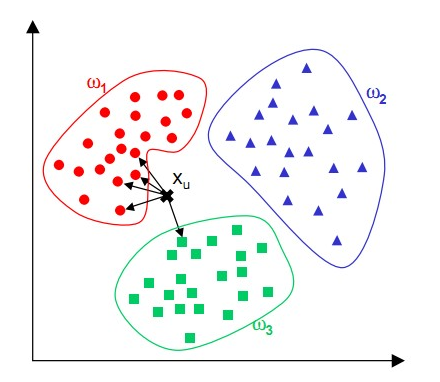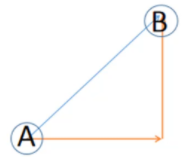文章链接:日撸 Java 三百行(总述)_minfanphd的博客-CSDN博客
51.1 KNN (K-NearestNeighbor) K指K个邻居
(1)正如物以类聚,人以群居。越是相似的东西就越有可能是一类东西。从这张图片来看,判断Xu属于那种类别,可以取Xu最近的K个邻居(距离),在这个K个点中,那一类东西的概率最高,就把他定位为那个类别。

其中距离的求解:
曼哈顿距离:
欧氏距离:(多维空间)

KNN算法最简单粗暴的就是将预测点与所有点距离进行计算,然后保存并排序,选出前面K个值看看哪些类别比较多。
(2)应用
比如在电商中,可以根据消费者选择的东西去推荐他们可能感兴趣的的商品,还可以在一些网站可以看到相似用户这些。
51.2.代码:
分享一个下载jar包的网址:https://mvnrepository.com/
1.aff内容解读
?在aff文件中有3种类型的花(山鸢尾(Iris-setosa),变色鸢尾(Iris-versicolor),维吉尼亚鸢尾(Iris-virginica)),每一个花类有50个数据,每条记录有 4 项特征(花萼长度、花萼宽度、花瓣长度、花瓣宽度)
2.步骤
(1)解析文本内容,获取数据集
(2)根据获取的数据集划分训练集和测试集,在分割数据集时打乱数据索引位置,以保证在取数时更有说服性
(3)对测试集数据进行预测:对每个测试数据,取他的k个邻居,这k个邻居时距离这个测试数据最近得k个点(计算距离用的欧式距离)
(4)取出的K个邻居,判断每个邻居属于哪一类型的
(5)测试其准确度
package machinelearning.knn;
import weka.core.Instances;
import java.io.File;
import java.io.FileReader;
import java.nio.channels.OverlappingFileLockException;
import java.util.Arrays;
import java.util.Random;
import java.util.function.IntFunction;
/**
* @author: fulisha
* @date: 2022/3/22 9:10
* @description: TODO
*/
public class KnnClassification {
//曼哈顿距离
public static final int MANHATTAN = 0;
//欧几里得距离
public static final int EUCLIDEAN = 1;
//距离测量
public static final int distanceMeasure = EUCLIDEAN;
//随机数
public static final Random random = new Random();
//邻居数量
int numNeighbors = 7;
//The whole dataset
Instances dataset;
//训练场地.由数据的索引表示
int[] trainingSet;
//测试集。由数据的索引表示。
int[] testingSet;
//预测
int[] predictions;
public KnnClassification(String paraFilename) {
try {
File file;
FileReader fileReader = new FileReader(paraFilename);
dataset = new Instances(fileReader);
//最后一个属性是decision类
dataset.setClassIndex(dataset.numAttributes() - 1);
fileReader.close();
} catch (Exception ee) {
System.out.println("Error occurred while trying to read \'" + paraFilename + "\' in KnnClassification constructor.\r\n" + ee);
System.exit(0);
}
}
/**
* 获取数据随机化的随机索引。
*
* @param paraLength The length of the sequence.
* @return An array of indices, e.g., {4, 3, 1, 5, 0, 2} with length 6.
*/
public static int[] getRandomIndices(int paraLength) {
int[] resultIndices = new int[paraLength];
// Step 1. Initialize.
for (int i = 0; i < paraLength; i++) {
resultIndices[i] = i;
}
// Step 2. Randomly swap.
int tempFirst, tempSecond, tempValue;
for (int i = 0; i < paraLength; i++) {
// Generate two random indices.
tempFirst = random.nextInt(paraLength);
tempSecond = random.nextInt(paraLength);
//swap
tempValue = resultIndices[tempFirst];
resultIndices[tempFirst] = resultIndices[tempSecond];
resultIndices[tempSecond] = tempValue;
}
return resultIndices;
}
/**
* 将数据分成培训和测试部分。
*
* @param paraTrainingFraction
*/
public void splitTrainingTesting(double paraTrainingFraction) {
int tempSize = dataset.numInstances();
int[] tempIndices = getRandomIndices(tempSize);
int tempTrainingSize = (int) (tempSize * paraTrainingFraction);
trainingSet = new int[tempTrainingSize];
testingSet = new int[tempSize - tempTrainingSize];
for (int i = 0; i < tempTrainingSize; i++) {
trainingSet[i] = tempIndices[i];
}
for (int i = 0; i < tempSize - tempTrainingSize; i++) {
testingSet[i] = tempIndices[tempTrainingSize + i];
}
}
/**
* 预测整个测试集。结果存储在predictions
*/
public void predict() {
predictions = new int[testingSet.length];
for (int i = 0; i < predictions.length; i++) {
predictions[i] = predict(testingSet[i]);
}
}
/**
* Predict for given instance
* @param paraIndex
* @return
*/
public int predict(int paraIndex) {
int[] tempNeighbors = computeNearests(paraIndex);
int resultPrediction = simpleVoting(tempNeighbors);
return resultPrediction;
}
/**
* 两个实例之间的距离。
* @param paraI The index of the first instance.
* @param paraJ The index of the second instance
* @return
*/
public double distance(int paraI, int paraJ) {
double resultDistance = 0;
double tempDifference;
switch (distanceMeasure) {
//曼哈顿距离
case MANHATTAN:
for (int i = 0; i < dataset.numAttributes() - 1; i++) {
tempDifference = dataset.instance(paraI).value(i) - dataset.instance(paraJ).value(i);
if (tempDifference < 0) {
resultDistance -= tempDifference;
} else {
resultDistance += tempDifference;
}
}
break;
//欧几里得距离
case EUCLIDEAN:
for (int i = 0; i < dataset.numAttributes() - 1; i++) {
tempDifference = dataset.instance(paraI).value(i) - dataset.instance(paraJ).value(i);
resultDistance += tempDifference * tempDifference;
}
break;
default:
System.out.println("Unsupported distance measure: " + distanceMeasure);
}
return resultDistance;
}
/**
* 获得分类器的准确度
* @return
*/
public double getAccuracy() {
double tempCorrect = 0;
for (int i = 0; i < predictions.length; i++) {
if (predictions[i] == dataset.instance(testingSet[i]).classValue()) {
tempCorrect++;
}
}
return tempCorrect / testingSet.length;
}
/**
* 计算最近的k个邻居.在每次扫描中选择一个邻居 事实上,我们只能扫描一次
* @param paraCurrent current instance. We are comparing it with all others.
* @return the indices of the nearest instances
*/
public int[] computeNearests(int paraCurrent) {
int[] resultNearests = new int[numNeighbors];
boolean[] tempSelected = new boolean[trainingSet.length];
double tempDistance;
double tempMinimalDistance;
int tempMinimalIndex = 0;
for (int i = 0; i < numNeighbors; i++) {
tempMinimalDistance = Double.MAX_VALUE;
for (int j = 0; j < trainingSet.length; j++) {
if (tempSelected[j]) {
continue;
}
tempDistance = distance(paraCurrent, trainingSet[j]);
if (tempDistance < tempMinimalDistance) {
tempMinimalDistance = tempDistance;
tempMinimalIndex = j;
}
}
resultNearests[i] = trainingSet[tempMinimalIndex];
tempSelected[tempMinimalIndex] = true;
}
System.out.println("The nearest of " + paraCurrent + " are: " + Arrays.toString(resultNearests));
return resultNearests;
}
/**
* 使用实例进行投票。
* @param paraNeighbors The indices of the neighbors.
* @return The predicted label.
*/
public int simpleVoting(int[] paraNeighbors) {
int[] tempVotes = new int[dataset.numClasses()];
for (int i = 0; i < paraNeighbors.length; i++) {
tempVotes[(int) dataset.instance(paraNeighbors[i]).classValue()]++;
}
int tempMaximalVotingIndex = 0;
int tempMaximalVoting = 0;
for (int i = 0; i < dataset.numClasses(); i++) {
if (tempVotes[i] > tempMaximalVoting) {
tempMaximalVoting = tempVotes[i];
tempMaximalVotingIndex = i;
}
}
return tempMaximalVotingIndex;
}
public static void main(String args[]) {
KnnClassification tempClassifier = new KnnClassification("D:/sampledata/iris.arff");
tempClassifier.splitTrainingTesting(0.7);
tempClassifier.predict();
System.out.println("The accuracy of the classifier is: " + tempClassifier.getAccuracy());
}
}
"C:\Program Files\Java\jdk1.8.0_271\bin\java.exe" "-javaagent:D:\Program Files\JetBrains\IntelliJ IDEA 2020.1.4\lib\idea_rt.jar=63850:D:\Program Files\JetBrains\IntelliJ IDEA 2020.1.4\bin" -Dfile.encoding=UTF-8 -classpath "C:\Program Files\Java\jdk1.8.0_271\jre\lib\charsets.jar;C:\Program Files\Java\jdk1.8.0_271\jre\lib\deploy.jar;C:\Program Files\Java\jdk1.8.0_271\jre\lib\ext\access-bridge-64.jar;C:\Program Files\Java\jdk1.8.0_271\jre\lib\ext\cldrdata.jar;C:\Program Files\Java\jdk1.8.0_271\jre\lib\ext\dnsns.jar;C:\Program Files\Java\jdk1.8.0_271\jre\lib\ext\jaccess.jar;C:\Program Files\Java\jdk1.8.0_271\jre\lib\ext\jfxrt.jar;C:\Program Files\Java\jdk1.8.0_271\jre\lib\ext\localedata.jar;C:\Program Files\Java\jdk1.8.0_271\jre\lib\ext\nashorn.jar;C:\Program Files\Java\jdk1.8.0_271\jre\lib\ext\sunec.jar;C:\Program Files\Java\jdk1.8.0_271\jre\lib\ext\sunjce_provider.jar;C:\Program Files\Java\jdk1.8.0_271\jre\lib\ext\sunmscapi.jar;C:\Program Files\Java\jdk1.8.0_271\jre\lib\ext\sunpkcs11.jar;C:\Program Files\Java\jdk1.8.0_271\jre\lib\ext\zipfs.jar;C:\Program Files\Java\jdk1.8.0_271\jre\lib\javaws.jar;C:\Program Files\Java\jdk1.8.0_271\jre\lib\jce.jar;C:\Program Files\Java\jdk1.8.0_271\jre\lib\jfr.jar;C:\Program Files\Java\jdk1.8.0_271\jre\lib\jfxswt.jar;C:\Program Files\Java\jdk1.8.0_271\jre\lib\jsse.jar;C:\Program Files\Java\jdk1.8.0_271\jre\lib\management-agent.jar;C:\Program Files\Java\jdk1.8.0_271\jre\lib\plugin.jar;C:\Program Files\Java\jdk1.8.0_271\jre\lib\resources.jar;C:\Program Files\Java\jdk1.8.0_271\jre\lib\rt.jar;D:\wzy\fls\weka-dev-3.9.3.jar;D:\wzy\fls\java-learn\out\production\java-learn" machinelearning.knn.KnnClassification
The nearest of 117 are: [131, 105, 109, 135, 125, 107, 118]
The nearest of 31 are: [20, 28, 36, 10, 39, 48, 23]
The nearest of 87 are: [68, 72, 62, 54, 74, 71, 58]
The nearest of 32 are: [46, 33, 19, 48, 10, 16, 5]
The nearest of 101 are: [149, 127, 138, 126, 123, 70, 111]
The nearest of 82 are: [92, 67, 71, 89, 96, 64, 80]
The nearest of 97 are: [74, 71, 91, 78, 61, 63, 75]
The nearest of 132 are: [103, 111, 112, 116, 147, 115, 137]
The nearest of 140 are: [144, 120, 112, 139, 115, 141, 102]
The nearest of 114 are: [149, 127, 138, 115, 126, 70, 148]
The nearest of 37 are: [34, 9, 1, 30, 12, 49, 29]
The nearest of 17 are: [40, 4, 39, 28, 7, 49, 26]
The nearest of 50 are: [52, 65, 76, 58, 75, 77, 51]
The nearest of 100 are: [144, 148, 120, 115, 112, 137, 103]
The nearest of 25 are: [34, 9, 1, 30, 45, 12, 29]
The nearest of 41 are: [8, 38, 45, 13, 12, 1, 3]
The nearest of 121 are: [149, 138, 70, 127, 126, 66, 84]
The nearest of 42 are: [38, 47, 3, 2, 8, 13, 29]
The nearest of 27 are: [28, 39, 48, 7, 4, 10, 40]
The nearest of 124 are: [120, 112, 144, 139, 137, 116, 102]
The nearest of 6 are: [47, 2, 11, 29, 3, 30, 40]
The nearest of 128 are: [103, 111, 116, 137, 112, 147, 115]
The nearest of 146 are: [123, 111, 126, 72, 133, 127, 119]
The nearest of 21 are: [19, 46, 4, 48, 40, 43, 26]
The nearest of 59 are: [89, 53, 80, 64, 96, 90, 92]
The nearest of 95 are: [96, 61, 55, 67, 66, 92, 90]
The nearest of 86 are: [52, 65, 58, 75, 76, 77, 51]
The nearest of 94 are: [96, 90, 89, 92, 55, 67, 53]
The nearest of 69 are: [80, 89, 92, 53, 67, 79, 62]
The nearest of 104 are: [112, 120, 144, 116, 103, 137, 115]
The nearest of 134 are: [103, 133, 111, 116, 137, 119, 72]
The nearest of 142 are: [149, 127, 138, 126, 123, 70, 111]
The nearest of 83 are: [133, 149, 123, 127, 72, 126, 138]
The nearest of 0 are: [4, 39, 28, 40, 7, 49, 48]
The nearest of 88 are: [96, 61, 66, 55, 92, 67, 84]
The nearest of 143 are: [120, 144, 102, 112, 139, 109, 125]
The nearest of 73 are: [63, 91, 78, 55, 72, 54, 74]
The nearest of 56 are: [51, 85, 91, 127, 70, 138, 63]
The nearest of 22 are: [2, 40, 47, 4, 35, 49, 11]
The nearest of 81 are: [80, 79, 89, 53, 92, 67, 64]
The nearest of 99 are: [96, 92, 67, 61, 89, 55, 71]
The nearest of 136 are: [148, 115, 144, 120, 137, 110, 112]
The nearest of 145 are: [141, 147, 139, 112, 115, 110, 120]
The nearest of 113 are: [149, 138, 126, 119, 123, 127, 70]
The nearest of 122 are: [105, 118, 107, 130, 135, 125, 102]
The accuracy of the classifier is: 0.9777777777777777
Process finished with exit code 0
总结:
今天是第一次接触机器学习,去看这个KNN分类器看得云里雾里的, 但是今天这个KNN分类器的基本思想是掌握了,但从知道到实现还是有一定距离。